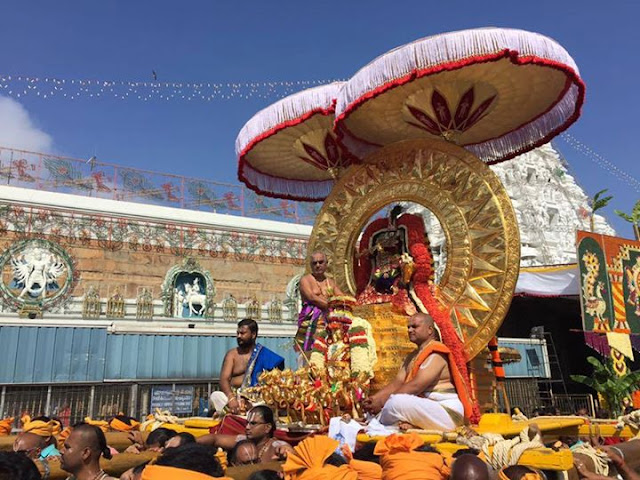Gita : Ch-8. Slo-25. Part-2.
Srimad Bhagavad-Gita :
Chapter-8 ( Akshara-brapma-yogam )
Slokam-25. [ The State of Re-birth- ( Punar-avarttanam gati ? ) ]
Part-2.
dhumo ratris tatha krishna san-masa dakshinayanam,
tatra candramasam jyotir yogi prapya nivartate.
dhumah, ratrih, tatha, krishnah; = smoke, night, also, the fortnight of the dark moon;
sat-masah, dakshina-ayanam = the six months, when the sun passes on the southern side;
tatra yogi = through the above path, the yogi who leaves ( discard ) his body and move on to;
candramasam, jyotih = the candralokam, the seat of decay, ( no progress place );
prapya, nivartate = achieves ( the above experience ) and returns ( comes back ).
RE-BIRTH ( PUNAR-AVARTTANAM ) :
Final Summation :
Now Lord Krishna explains the path that leads to a return of rebirth in the material existence.
When one accedes to death at the times presided by the demigods identified with smoke, with night, with the waning moon and with the suns waning southern course guided on these paths those who performed ritualistic Vedic activities will reach the celestial heavens and after amply enjoying the fruits of their actions will return again and be reborn in the world of mortals.
The Brihadaranyaka Upanisad VI.II.XVI states: They first reach the demigod identified with smoke, etc.
Thus by mediation and performing selfless Vedic activities without desire for rewards one gradually achieves moksa or liberation from material existence and those who perform Vedic activities with a desire for rewards and benefits return to the material worlds after enjoying their accumulated merit in the heavens.
But those who go against the injunctions of the Vedic scriptures and do prohibited activities only return to material worlds after prolonged and agonising suffering in the lower hellish planets when all their demerits have been purged.
While ordinary creatures of flora and fauna are reborn again and again incessantly and continuously.
Now Lord Krishna speaks of the path by which there is a return of rebirth in the world of mortals.
This path is the path where the manes or ancestors are situated and wherein are stationed the demigods presiding over smoke, night, the dark fortnight of the moon, the six months of the suns waning southern course.
The aspirant who is devoted to self aggrandising Vedic activities for attaining the pleasures of the heavenly realms and also for doing public welfare works like excavating drinking water and feeding the poor to gain merit are all considered fruitive actions seeking rewards.
After death such aspirants are led by the aforementioned presiding demigods one after another in ascending succession until they reach Svargaloka the heavenly realms where they enjoy the rewards of their material activities until the merits of their worldly deeds are finished, at which time they return to the world of mortals and are born again.
Here the words dhumo and ratris meaning smoke and night respectively signify the presiding demigods of Pitriloka the world of the manes.
The Chandogya Upanisad V.X.III-VI states: Those who perform Vedic activities like yagna or propitiation and worship for the sake of acquiring merit as well those doing philanthropic activities such as donating food and land for the sake of acquiring merit, both are guided by the presiding demigods of the smoke, then the night, then the dark moon fortnight and then to the presiding demigod of the sun in its six months waning southern course.
These do not reach the presiding demigod of the year as they are routed to Pitriloka and from there to space, then to the heavenly realms where they enjoy rewards of there good deeds until their merits have shrunk to residue and expired. Afterwards these beings return to be reborn in the world of mortals by the same way back which they have come, from the heavenly realms to the space and all the way down to the smoke where they began.
But to be reborn they must transition from the smoke to the mist and from the mist to the clouds, from the clouds they transition to rain which falls upon the ground and then transitioning they are born on Earth in the forms of rice, barley and other grains as well as herbs and sesame plants and various types of beans.
Thus it is very difficult to evolve from this position because only if these different flora are eaten by human or animal and subsequently emitted as semen into the womb of a fertile female do they become an embryo and entering material existence are able to develop further.
The Chandogya Upanisad VII.X.VII states: Accordingly those of righteous conduct in their previous life will take birth as a human in the family of righteous parents.
Whereas those of abominable conduct in their previous life will take birth in the abominable wombs of dogs, pigs and unclean beings.
Therefore those aspirants for moksa or liberation from material existence should strive to realise the brahman or the spiritual substratum pervading all existence and achieve the path which leads to the cessation of rebirth no longer returning to the material existence as elaborated by Lord Krishna in the previous slokam.
The word dhumah meaning smoke indicates the presiding demigod of the path in which lies the Pitri-loka the realm of the manes or ancestors. The word yogi has been used to denote a spiritual person who performs Vedic activities.
To be continued ...





Comments
Post a Comment